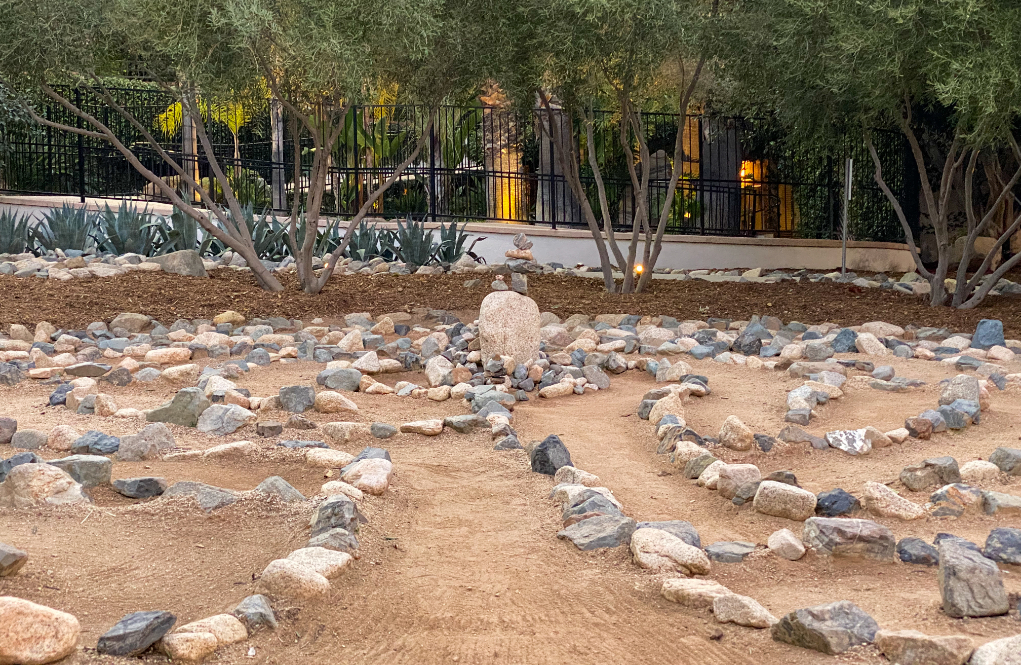3By Julie Diebolt Price
Photographer, Author
linktr.ee/PhotoTravelWrite
Today, there are 6,000 labyrinths worldwide in 88 different countries. Countless people from all walks of life worldwide are intrigued by this ancient symbol of wholeness–a meandering but purposeful path.
If you want to collect experiences instead of “stuff,” you will find labyrinths a unique and exciting experience to add to your travels throughout the United States and abroad. Perfect for families, couples, and solo travelers, walking a labyrinth is enriching for mind and body.

History of Labyrinths
Labyrinths were initially connected to Greek legends and symbolized fear and an overwhelming sense of evil. Christianity adopted the labyrinth, which took on a cosmic and religious significance. Its geometric perfection was considered flawless, with the circle symbolizing divine unity with no beginning or end. With the unique alteration of superimposing the cross in the center, this style of labyrinth multiplied worldwide. It’s referred to as the Chartres-type labyrinth.
Chartres Cathedral
 Chartres Cathedral, located in Notre-Dame de Chartres, France, was built around 1214 during the Gothic period. During the Crusades, the pilgrimage to the Holy City of Jerusalem was perilous and difficult.
Chartres Cathedral, located in Notre-Dame de Chartres, France, was built around 1214 during the Gothic period. During the Crusades, the pilgrimage to the Holy City of Jerusalem was perilous and difficult.
One of seven European cathedrals designated “Jerusalem” by The Church, Chartres Cathedral became the final stage of a pilgrimage. Some pilgrims completed the labyrinth on their knees to gain forgiveness and as an act of repentance.
Most people couldn’t read, so the sacred geometry of the labyrinth imparted significant Church doctrine. Chartres is the most famous medieval labyrinth.
As a young traveler and with the ignorance of youth, I visited Chartres Cathedral and walked the labyrinth. It’s one of the most-walked labyrinths today.
Labyrinth Meditation
A labyrinth used for walking meditation is a single spiral path from the outside into the center of a large circle. Here are some of the benefits.
• quiet and unwind the mind
• calm your anxieties
• recover balance in your life
• enhance creativity
• encourage meditation
• gain insight
• self-reflection
• stress reduction
Labyrinths Today
Labyrinths are no longer evil and are symbols of peace. They are symbols for pilgrims and are part of their religious journey.
The world’s largest labyrinth is in Costa Rica and is publicized as a spiritual theme park.
 The Tamarindo Labyrinth, located on the outskirts of the beach town Guanacaste, is the world’s largest labyrinth. The winding path runs 1.7 miles from start to finish.
The Tamarindo Labyrinth, located on the outskirts of the beach town Guanacaste, is the world’s largest labyrinth. The winding path runs 1.7 miles from start to finish.
There is no set prescription to walk a labyrinth. Griet Depypere, the owner of Tamarindo Labyrinth, said walking a labyrinth gives you a sense of bliss and freedom. You must sense your body, don’t think about it.
Many religions and cultures today use the ancient practice of labyrinth walking, such as Christianity, Buddhism, Jewish, and Pagan. With a wide variety of settings, labyrinths are located at hospitals, churches, backyards, and beaches for spiritual centering, contemplation, and prayer.
Why Visit Labyrinths
Studying labyrinths is a new interest and pastime for me. Learning the maker’s style, choice of materials, and design for their labyrinth is fascinating. More than spiritual traditions, scheduling a labyrinth stop gives a unique purpose to visiting a destination.
Labyrinth materials may include travertine marble, rocks, stones, bushes, or cacti.
Walking a labyrinth is wholesome entertainment for families with children. Treating it like a game is not disrespectful to express joy and have fun.
You don’t have to be a believer in any religion to participate.
In many cases, the labyrinth is free and is open 24/7.
How to Walk a Labyrinth
There is no right or wrong way to walk a labyrinth. Children may go in and out many times as they run and play. Some people spend 15 minutes; others may spend an hour as they meditate and observe or pray.
At the opening or mouth of the labyrinth, pause to focus on your intention of mindfulness. Reflect on the purpose of your walk. If you are looking for a solution to a problem, want to receive inspiration, or let go of a burden, do so when you reach the center.
If you encounter other people going in the opposite direction, step off the path and allow them to pass.
After pausing in the center, retrace your steps, always moving forward until you reach the mouth. Finish with some acknowledgment–mine is “Fini.”
Pro Tip: Plan your visit for early morning or late afternoon when the day’s heat has passed. I walked quickly on my most recent visit because of the triple-digit heat.

The Labyrinth Society
Labyrinth lovers make up The Labyrinth Society. Members from all over the world volunteer to support their mission as a non-profit organization. Regional and national events bring together labyrinth enthusiasts for meaningful events like birthday parties, weddings, and forums for connecting with other enthusiasts.
The Labyrinth Society promotes further understanding of the labyrinth as a tool for personal and community transformation with a higher level of human awareness. They offer expertise in education, networking, and sharing opportunities for experiencing change.
World Labyrinth Day
On the first Saturday of May yearly, thousands worldwide participate in moving meditation for world peace and celebrate the labyrinth experience. The Labyrinth Society sponsors this annual event.
Find a Labyrinth Near Me
The Labyrinth Locator is a project of The Labyrinth Society and Veriditas, which is a database of worldwide labyrinths. This easy-to-use database (I only enter the city and state on their search page) serves up all the public and private labyrinths in the area with contact information, hours, and more. The database is a great tool when planning a visit; you can keep it updated with your contributions after your visit. What a great family project!
Cost and Open Hour
In many cases, labyrinths are open to the public, with set hours, and are free. Those on private property may not be open to the public, and others may be available by appointment. Use The Labyrinth Society’s locator to learn everything you need to know for your visit.
Final Thoughts
I discovered that you can’t get lost in a labyrinth. Three times on a recent walk, I thought I might not have followed the path correctly. However, after a brief hesitation, I realized the simplicity of the course and its purpose. Keep moving forward toward the center and forward when you are retracing your steps. There are no dead ends—only one way in and one way out.
 Extended Weekend Getaways
Extended Weekend Getaways 